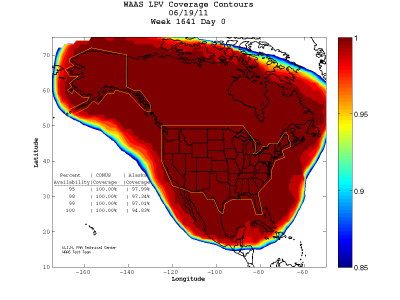If you wish to contribute or participate in the discussions about articles you are invited to contact the Editor
WAAS Performances: Difference between revisions
| Line 17: | Line 17: | ||
The WAAS Performance Requirements as specified in [http://www.faa.gov/about/office_org/headquarters_offices/ato/service_units/techops/navservices/gnss/library/documents/media/waas/2892bC2a.pdf FAA ''Specification for the Wide Area Augmentation System(WAAS)''] document are the following; | The WAAS Performance Requirements as specified in [http://www.faa.gov/about/office_org/headquarters_offices/ato/service_units/techops/navservices/gnss/library/documents/media/waas/2892bC2a.pdf FAA ''Specification for the Wide Area Augmentation System(WAAS)''] document are the following; | ||
# WAAS Performance Requirements for Non-Precision Approach | # WAAS Performance Requirements for ''Non-Precision Approach'' {| class="wikitable" align="center" | ||
{| class="wikitable" align="center" | |||
|+align="bottom" |''Performances Requirements for Non-Precison Approach'' | |+align="bottom" |''Performances Requirements for Non-Precison Approach'' | ||
! Performance Requirement | ! Performance Requirement | ||
| Line 50: | Line 49: | ||
| <br /> 1 - 10e-5/hour <br /> 1 - 10e-5/hour | | <br /> 1 - 10e-5/hour <br /> 1 - 10e-5/hour | ||
|} | |} | ||
# WAAS Performance Requirements for Precision Approach | # WAAS Performance Requirements for ''Precision Approach'' {| class="wikitable" align="center" | ||
{| class="wikitable" align="center" | |||
|+align="bottom" |''Performances Requirements for Precison Approach'' | |+align="bottom" |''Performances Requirements for Precison Approach'' | ||
! Performance Requirement | ! Performance Requirement | ||
Revision as of 13:41, 26 July 2011
| WAAS | |
|---|---|
| Title | WAAS Performances |
| Author(s) | GMV. |
| Level | Basic |
| Year of Publication | 2011 |
The Wide Area Augmentation System (WAAS) is the United States Satellite Based Augmentation System. The programme, started in 1992, is being carried out by the Federal Aviation Agency (FAA)[1] and is specially developed for the civil aviation community.[2] The system, which was declared operational in late 2003,[3] currently supports thousands of aircraft instrument approaches in more than one thousand airports in USA and Canada.[4] WAAS service area includes CONUS, Alaska, Canada and Mexico.[5] The WAAS programme is continuously in evolution; two development phases have been already covered, a third is in progress, and there are plans to improve the capability of the system in parallel with the evolution of the SBAS standards towards a dual-frequency augmentation service.[6]
WAAS Performances
Performances are usually described in terms of accuracy, integrity, availability and continuity. The WAAS specification Performance Requirements[7] are different depending on the phase of the flight: en route through 1) Non-precision approach (NPA) and 2) Precision Approach.
The WAAS Performance Requirements as specified in FAA Specification for the Wide Area Augmentation System(WAAS) document are the following;
- WAAS Performance Requirements for Non-Precision Approach {| class="wikitable" align="center"
|+align="bottom" |Performances Requirements for Non-Precison Approach
! Performance Requirement
! Total System
! Navigation System
! WAAS Signal-in-Space
! Airborne
|- align="center"
! Availability
| 0.999
| 0.999
| 0.999
| Not Specified (N/S)
|- align="center"
| Accuracy
95% Horizontal Position
99.999% Horizontal Position
95% Vertical Position
95% Pseudorange
|
N/S
N/S
N/A
N/A
|
100 m
500 m
N/A
N/S
|
N/S
N/S
N/A
N/S
|
N/S
N/S
N/A
1.2 m
|- align="center"
| Integrity
Integrity Risk
Time-to-Alarm
|
N/S
10 s
|
N/S
10 s
|
10e-7/hour
8 s
|
N/S
2 s
|- align="center"
| Continuity
Continuity of Navigation
Continuity of Fault Detection
|
1 - 10e-5/hour
1 - (2x10e-5)/hour
|
1 - 10e-5/hour
1 - (2x10e-5)/hour
|
1 - 10e-8hour
1 - 10e-5/hour
|
1 - 10e-5/hour
1 - 10e-5/hour
|}
- WAAS Performance Requirements for Precision Approach {| class="wikitable" align="center"
|+align="bottom" |Performances Requirements for Precison Approach
! Performance Requirement
! Total System
! Navigation System
! WAAS Signal-in-Space
! Airborne
|- align="center"
! Availability
| Not Specified (N/S)
| N/S
| 0.999
| N/S
|- align="center"
| Accuracy
95% Horizontal Position
95% Vertical Position
95% Pseudorange
|
33.5 m
9.8 m
N/A
|
7.6 m
7.6 m
N/S
|
N/S
N/S
N/S
|
N/S
N/S
1.2 m
|- align="center"
| Integrity
Integrity Risk
Time-to-Alarm
|
N/S
N/S
|
N/S
N/S
|
10e-7/approach
5.2 s
|
N/S
N/S
|- align="center"
| Continuity of Function
Continuity of Navigation
Continuity of Fault Detection
| 1 - 10e-4/approach
N/S
N/S
| 1 - 10e-4/approach
N/S
N/S
| 1 - (5.5x10e-5)/approach
N/S
N/S
| 1 - (4.5x10e-5)/approach
N/S
N/S
|}
On July 10, 2003, the WAAS system was certified for for safety-of-life aviation, covering 95% of the United States, and portions of Alaska [8]. At present, WAAS supports en-route, terminal and approach operations down to a full LPV-200 (CAT-I like Approach Capability) for the CONUS, Mexico and Canada. Typical performances provided by WAAS System when considering operating in LPV (Horizontal Alarm Limit = 40 m , Vertical Alarm Limit =50 m) are shown in next figure:[9]
Notes
References
- ^ Navigation Services - History - Satellite Navigation, FAA.
- ^ Navigation Services - Wide Area Augmentation System (WAAS), FAA.
- ^ Wide Area Differential GPS (WADGPS), Stanford University
- ^ GNSS - GPS/WAAS Approaches, Federal Aviation Agency (FAA).
- ^ WAAS Service Expanded into Canada and Mexico, September 28, 2007, Federal Aviation Agency (FAA).
- ^ SatNav News, Vol. 33, March 2008, Federal Aviation Agency (FAA).
- ^ FAA.Specification for the Wide Area Augmentation System(WAAS). FAA-E- 2892b. August 13, 2001.
- ^ Wide Area Augmentation System
- ^ FAA Monitoring WAAS Performances in Real-Time

